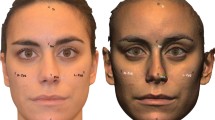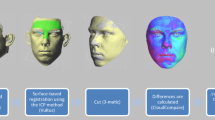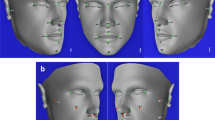Abstract
Purpose
To compare the accuracy of three-dimensional (3D) facial scans captured by smartphone applications with a clinically approved portable stereophotogrammetry device.
Methods
Morphometric markers were placed on 8 points on the face of 50 participants. Facial 3D scans were captured with a LiDAR camera on an iPad Pro using five smartphone applications (Heges 3D Scanner, Bellus FaceMaker, ScandyPro, Scaniverse and Trnio) and a stereophotogrammetric 3D Vectra H1 camera. The standard triangle language (stl.) format of the smartphone facial scans were automatically surface-based spatially aligned on the 3D Vectra H1 stl. of the corresponding participant. Linear and 3D measurements were performed in 3-Matic software.
Results
The largest linear differences were found between the morphometric points of the Heges 3D scanner (3.4 ± 1.5 mm) and ScanyPro (4.4 ± 2.1 mm), and Vectra H1, while the smallest deviations were seen for the Bellus FaceMaker (2.2 ± 1.2 mm) and Trnio (2.9 ± 1.5 mm). Identical findings were obtained for the 3D comparison. The smallest deviation was seen for the chin and forehead in all applications.
Conclusion
From the five tested smartphone applications, three showed sufficient accuracy for facial scanning purposes.
Graphical Abstract




Similar content being viewed by others
Data Availability
The data presented in this study are available on request from the corresponding author.
References
Gibelli, D., Codari, M., Rosati, R., Dolci, C., Tartaglia, G. M., Cattaneo, C., & Sforza, C. (2015). A quantitative analysis of lip aesthetics: The influence of gender and aging. Aesthetic Plastic Surgery, 39(5), 771–776. https://doi.org/10.1007/s00266-015-0495-7
Sawyer, A. R., See, M., & Nduka, C. (2009). 3D stereophotogrammetry quantitative lip analysis. Aesthetic Plastic Surgery, 33(4), 497–504. https://doi.org/10.1007/s00266-008-9191-1
Hong, C., Choi, K., Kachroo, Y., Kwon, T., Nguyen, A., McComb, R., & Moon, W. (2017). Evaluation of the 3dMDface system as a tool for soft tissue analysis. Orthodontics and Craniofacial Research, 20, 119–124. https://doi.org/10.1111/ocr.12178
Codari, M., Pucciarelli, V., Pisoni, L., & Sforza, C. (2015). Laser scanner compared with stereophotogrammetry for measurements of area on nasal plaster casts. British Journal of Oral and Maxillofacial Surgery, 53(8), 769–770. https://doi.org/10.1016/j.bjoms.2015.05.007
Wong, J. Y., Oh, A. K., Ohta, E., Hunt, A. T., Rogers, G. D. F., Mulliken, J. B., & Deutsch, C. K. (2007). Validity and reliability of craniofacial anthropometric measurement of 3D digital photogrammetric images. Society of Plastic and Reconstructive Surgeons Inc., 45(3), 232–239. https://doi.org/10.1597/06-175.1
Gibelli, D., Pucciarelli, V., Cappella, A., Dolci, C., & Sforza, C. (2018). Are portable stereophotogrammetric devices reliable in facial imaging? A validation study of VECTRA H1 device. Journal of Oral and Maxillofacial Surgery, 76(8), 1772–1784. https://doi.org/10.1016/j.joms.2018.01.021
Tzou, C. H. J., Artner, N. M., Pona, I., Hold, A., Placheta, E., Kropatsch, W. G., & Frey, M. (2014). Comparison of three-dimensional surface-imaging systems. Journal of Plastic, Reconstructive and Aesthetic Surgery, 67, 489–497. https://doi.org/10.1016/j.bjps.2014.01.003
Chung, H. K., Richmond, S., Incrapera, A., English, J., & Xia, J. J. (2007). Three-dimensional surface acquisition systems for the study of facial morphology and their application to maxillofacial surgery. International Journal of Medical Robotics and Computer Assisted Surgery. https://doi.org/10.1002/rcs.141
Akan, B., Akan, E., Şahan, A. O., & Kalak, M. (2021). Evaluation of 3D face-scan images obtained by stereophotogrammetry and smartphone camera. International Orthodontics, 19(4), 669–678. https://doi.org/10.1016/j.ortho.2021.08.007
Volonghi, P., Baronio, G., & Signoroni, A. (2018). 3D scanning and geometry processing techniques for customised hand orthotics: An experimental assessment. Virtual and Physical Prototyping, 13(2), 105–116. https://doi.org/10.1080/17452759.2018.1426328
Mai, H. N., & Lee, D. H. (2020). Accuracy of mobile device-compatible 3D scanners for facial digitization: Systematic review and meta-analysis. Journal of Medical Internet Research, 22(10), 1–13. https://doi.org/10.2196/22228
Camison, L., Bykowski, M., Lee, W. W., Carlson, J. C., Roosenboom, J., Goldstein, J. A., Losee, J. E., & Weinberg, S. M. (2018). Validation of the Vectra H1 portable three-dimensional photogrammetry system for facial imaging. International Journal of Oral and Maxillofacial Surgery, 47(3), 403–410. https://doi.org/10.1016/j.ijom.2017.08.008
Nightingale, R. C., Ross, M. T., Cruz, R. L. J., Allenby, M. C., Powell, S. K., & Woodruff, M. A. (2021). Frugal 3D scanning using smartphones provides an accessible framework for capturing the external ear. Journal of Plastic, Reconstructive and Aesthetic Surgery, 74(11), 3066–3072. https://doi.org/10.1016/j.bjps.2021.03.131
Alazzam, A., Aljarba, S., Alshomer, F., & Alawirdhi, B. (2021). The utility of smartphone 3D scanning, open-sourced computer-aided design, and desktop 3D printing in the surgical planning of microtia reconstruction: A step by step guide and concept assessment. JPRAS Open, 30, 17–22. https://doi.org/10.1016/j.jpra.2021.06.001
Dzelzkaleja, L., Knets, J. K., Rozenovskis, N., & Sılıtis, A. (2021). Mobile apps for 3D face scanning. Intelligent Systems and Applications, 2, 34–50.
Chambers, J., & Hullette, T. (2021). The best 3D scanner apps of 2022 (iPhone & Android). ALL3DP. Retrieved Aug 25, 2021, from https://all3dp.com/2/best-3d-scanner-app-iphone-android-photogrammetry/
Cherdo, L. (2021). The best 3D scanning apps for smartphones in 2022. Aniwaa. Retrieved Aug 25, 2021, from https://www.aniwaa.com/buyers-guide/3d-scanners/best-3d-scanning-apps-smartphones/
M., A. (2021, Mar 26). The best 3D scanning apps for smartphones in 2022. 3D Natives. Retrieved Aug 25, 2021, from https://www.3dnatives.com/en/top-3d-scanner-apps-050820204/
Sandofsky, B. (2018, Oct 29). iPhone XR: A deep dive into depth. lux.camera. Retrieved July 25, 2022, from https://lux.camera/iphone-xr-a-deep-dive-into-depth/
Amornvit, P., & Sanohkan, S. (2019). The accuracy of digital face scans obtained from 3D scanners: An in vitro study. International Journal of Environmental Research and Public Health, 16(24), 5061. https://doi.org/10.3390/ijerph16245061
van Dessel, J., Nicolielo, L. F. P., Huang, Y., Coudyzer, W., Salmon, B., Lambrichts, I., & Jacobs, R. (2017). Accuracy and reliability of different cone beam computed tomography (CBCT) devices for structural analysis of alveolar bone in comparison with multislice CT and micro-CT. Article in European Journal of Oral Implantology, 10(1), 95–105.
van Dessel, J., Nicolielo, L. F. P., Huang, Y., Slagmolen, P., Lambrichts, I., & Jacobs, R. (2016). Quantification of bone quality using different cone-beam CT devices: Accuracy 1 assessment for edentulous human mandibles. European Journal of Oral Implantology, 9(4), 411–424.
Pellitteri, F., Brucculeri, L., Spedicato, G. A., Siciliani, G., & Lombardo, L. (2021). Comparison of the accuracy of digital face scans obtained by two different scanners: An in vivo study. Angle Orthodontist, 91(5), 641–649. https://doi.org/10.2319/092720-823.1
Piedra-Cascón, W., Meyer, M. J., Methani, M. M., & Revilla-León, M. (2019). Accuracy (trueness and precision) of a dual-structured light facial scanner and interexaminer reliability. The Journal of Prosthetic Dentistry, 124(5), 567–574.
Acknowledgements
This study was supported a grant from the Institute of Oral and Maxillofacial Surgery Education and Training (IOMFCOT), Leuven, Belgium. We would like to acknowledge Maximiliaan Smeets, Melisa Garip, Tomas-Marijn Croonenborghs and Thomas Aerden for their feedback on the study design. We thank Marel Simonik for providing us free access to Heges 3D scanner.
Funding
The authors declare that no funds, grants or other support were received during the preparation of this manuscript.
Author information
Authors and Affiliations
Contributions
Conceptualization: LVL, LC, MB and JVD; Methodology: LVL, YS and JVD; Software: LVL and JVD; Validation: LVL and VS; Formal Analysis: LVL, VS and JVD; Investigation: LVL, LC and JVD; Resources: MB, RW, YS and JVD; Data Curation: LVL; Writing—Original Draft Preparation: LVL and JVD; Writing—Review & Editing: LC, VS, MB, RW and YS; Visualization: LVL and JVD; Supervision: JVD; Project Administration: JVD.
Corresponding author
Ethics declarations
Competing interest
The authors have no relevant financial or non-financial interests to disclose.
Institutional Review Board Statement
The study was performed in line with the principles of the Declaration of Helsinki. Approval was granted by the Ethics Committee of KU/UZ Leuven (07/04/2022, S66188).
Consent to Participate
Informed consent was obtained from all individual participants included in the study.
Consent to Publish
The authors affirm that human research participants provided informed consent for publication of the images in the Graphical Abstract, Figs. 1a–c, 2 and Tables 1 and 2.
Rights and permissions
Springer Nature or its licensor (e.g. a society or other partner) holds exclusive rights to this article under a publishing agreement with the author(s) or other rightsholder(s); author self-archiving of the accepted manuscript version of this article is solely governed by the terms of such publishing agreement and applicable law.
About this article
Cite this article
Van Lint, L., Christiaens, L., Stroo, V. et al. Accuracy Comparison of 3D Face Scans Obtained by Portable Stereophotogrammetry and Smartphone Applications. J. Med. Biol. Eng. 43, 550–560 (2023). https://doi.org/10.1007/s40846-023-00817-9
Received:
Accepted:
Published:
Issue Date:
DOI: https://doi.org/10.1007/s40846-023-00817-9




